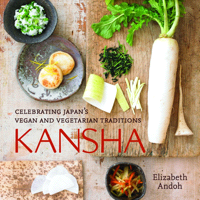Elizabeth Andoh ‘s Kansha: Celebrating Japan’s Vegan and Vegetarian Traditions (Ten Speed 2010) is another of her marvelous, traditional cookbooks full of recipes — both simple and complex — that focus on bringing out the flavors of ingredients, colors and textures, and taste. (See previous review of Washoku).
This time, the topic is vegetarian.
 If you are not yet familiar with Japanese vegetarian cooking, Elizabeth’s recipes are carefully detailed: even a novice can follow her instructions. The recipes range from simple rice dishes to fresh bamboo and how to make pickles. The photographs of finished dishes by Leigh Beisch that will inspire you to try these recipes.
If you are not yet familiar with Japanese vegetarian cooking, Elizabeth’s recipes are carefully detailed: even a novice can follow her instructions. The recipes range from simple rice dishes to fresh bamboo and how to make pickles. The photographs of finished dishes by Leigh Beisch that will inspire you to try these recipes.
Sushi doesn’t have to include raw fish to be delicious: try pompom sushi (pp. 43-44), those marvelous marble-size colorful balls of vegetables and tart sushi rice. There many other interesting rice dishes including Rice Tossed with Radish Greens (p. 23) and a more unusual Black Rice with Green Soybeans (p.19) that is not only simple to make but combines colors on a white plate like a Japanese painting. The noodle dishes include Sansai Soba, soba noodle soup with mountain vegetables (pp. 70-71).
You know how you always throw out the thick broccoli thick stems?
Elizabeth cuts them in thin slices and adds them to fiddlehead ferns and shiitake mushrooms to make a colorful appetizing dish.
There are also wonderful recipes with tofu, soups and even vegetable desserts for those on a diet who are worried about eating too many holiday sweets. Japanese desserts are never overly sweet and very healthy.
At the end of the book there is a shopping lists of ingredients you should store in your pantry to have ready to use when you decide it is time to serve a Japanese dinner and a few kitchen utensils which are a must to make some of these delicious recipes.
RECIPE Fresh Soy Milk Sheets
(pp.160-161)Serves 2 or 3
2 cups soymilk, preferably rich (with a high soy-solid content) and freshly extracted (page 156)
1/2-teaspoon wasabi paste
Soy sauce or Vegan Seasoned Soy Concentrate (page 331)Ideally your stovetop provides a low but steady source of cooking heat. Place a 7- or 8-inch shallow skillet or pan, preferably nonstick, over low heat for about 1 minute. Slowly pour the soymilk into the warm pan. It should be about 1/4 inch deep. Adjust the heat to the lowest possible setting and allow the soymilk to heat undisturbed.
After several minutes, you will notice the surface of the soymilk beginning to thicken. At this point, the temperature of the soymilk will probably be 140 F. Using an uchiwa (page 248) or a flat piece of cardboard (about 8 by 11 inches) gently fan the air above the pan to cause a drop in air temperature; this, in turn will cool the surface of the warm soy milk. When the surface of the soymilk cool but the liquid beneath is still warm, wrinkles will form and this surface will thicken, making sheets of nama yuba.
Using a thick chopstick (or wooden knitting needle), scoop under and lift up the sheet and drape it across a small serving plate. Choosing a dark or brightly colored plate for dramatic presentation. Continue to fan, scoop and lift sheet, arranging 2 or 3 of them slightly overlapping each other on each plate. You should be able to pull at least 8 sheets, and possibly 12 or more, from 2 cups of soymilk. The sheets will be wrinkled, not smooth.
Set a small mound of wasabi on, or near, the fresh yuba. Pour a small amount of soy sauce into individual dipping bowls. Each diner dissolves wasabi to his or her taste in his or her soy sauce before grasping a yuba sheet, dipping it in the sauce, and enjoying.

1 comments on “Kansha: Celebrating Japan’s Vegan and Vegetarian”